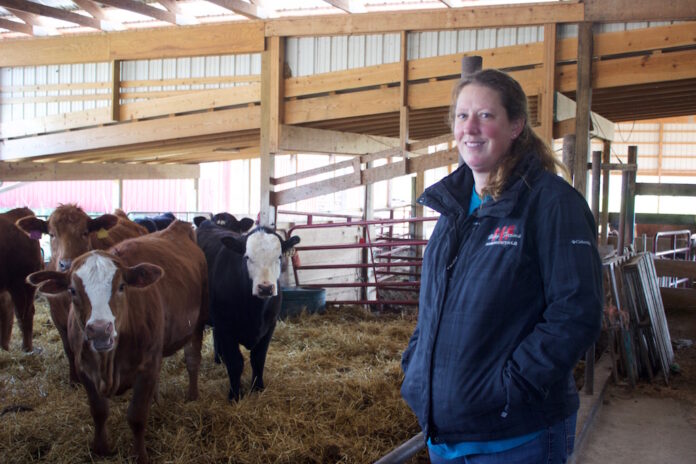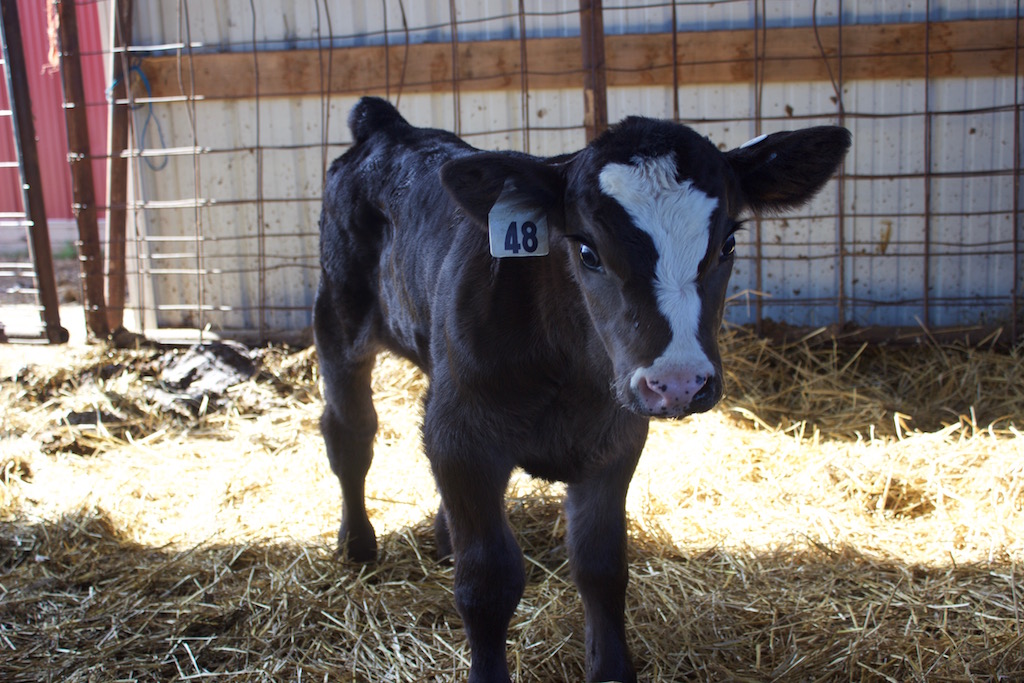
WEST SALEM, Ohio — Pam Haley, a cattle farmer and board member for the Ohio Cattlemen’s Association, has used electronic ID on her farm for several years. Those tags would allow animal health officials to trace cattle with any potential problems back to her farm.
“I want to be the first one that knows that the problem came from me — not the last one — and not the one they’re searching for,” Haley said. “I think it’s our responsibility as producers to be in the forefront of that.”
She hauls and sells her cattle across the country. On a Thursday in April, she had several cow-calf pairs getting ready to go to a sale in West Virginia. In the week or so leading up to the sale, she had a veterinarian out to look over the animals, and put electronic tags in the calves’ ears — the cows already had them.
It’s not hard to find examples of severe livestock disease outbreaks or disease threats, from avian influenza, to African swine fever, to scrapie. When disease outbreaks arise, animal health officials need to track them back to their sources, in order to figure out the extent of the exposure.
The U.S. Department of Agriculture has regulations on animal disease traceability. But the rules don’t cover all livestock — for example, feeder cattle are typically not required to be officially identified. That leaves room for some serious issues if the U.S. faces a significant disease outbreak in cattle.
Regulation
The USDA has made multiple attempts to increase regulation on animal disease traceability. After a failed National Animal Identification System, which only got about 36% of producers to sign up despite more than $120 million invested, the USDA came out with a new Animal Disease Traceability rule in 2013.
The rule requires livestock to be officially identified when moving interstate, and to be accompanied by a movement document, like an interstate certificate of veterinary inspection. The requirements for each species include more details.
For example, it only applies to cattle that are sexually intact and 18 months or older; female dairy cattle and dairy males born after March 11, 2013; and cattle used for rodeo, recreational events, shows or exhibitions.
“There’s literally millions of head of cattle under 18 months of age moving across state lines that there’s nothing being done for traceability,” said Bill Tom, executive vice president of livestock marketing for United Producers, Inc., and vice president of the Ohio Cattlemen’s Association.
But some groups were satisfied with that rule. Bill Bullard, CEO of R-CALF USA, said future changes should come from the marketplace.
“We believe that the 2013 rule addresses the disease traceability needs of regulators,” Bullard said. “But we are very much opposed to any further mandates.”
R-CALF was one of the major opponents of a USDA attempt to mandate electronic ID.
The plan was to require cattle 18 months and older traveling interstate to have electronic ID by 2023. R-CALF sued, saying the USDA did not go through proper rulemaking, and the USDA dropped the mandate, but said it planned to pursue rulemaking in 2021.
In March of 2022, a USDA spokesperson told Farm and Dairy the USDA did not have any updates on the status of that rulemaking.

Electronic ID
Angela Rospert, a field veterinarian with the Ohio Department of Agriculture, said animal health officials are still encouraging electronic ID.
There are reasons they’re in favor of it. It requires less hands-on work to read tags and cuts down on errors with transcribing tag numbers, compared with other methods, like plastic tags or tattoos.
Usually, when an animal tests positive for a disease, the department of agriculture has a few pieces of information, like the animal’s ID number and the place where it was when it tested positive, Rospert said. Then, staff have to track where the animal was before and after that.
“We’re pretty much doing each movement piece by piece by piece to make this bigger picture,” Rospert said.
The biggest challenge Rospert and other officials face, she said, is issues with records. Some livestock markets still use paper records. That means someone has to spend time flipping manually through documents until they find what they need — if the information is even there.
If records are incomplete or unavailable, it’s difficult, if not impossible, to trace an outbreak.
While the department does not specifically track costs of tracing disease outbreaks, a department spokesperson said electronic records and ID does make tracing faster and more efficient. That saves time and costs for both the department and farmers.
It’s hard to say exactly how many beef cattle farms are using electronic ID. The USDA estimated 10 million official RFID tags, and more unofficial electronic ID tags, are used annually, but only 11% of U.S. cattle require official ID.
The main drivers of electronic ID for beef cattle are programs that require it, and feed yards that use it to help track or manage cattle, said Nevil Speer, an industry consultant who has focused on traceability in the cattle industry for about 25 years.
The cost of electronic ID can be a barrier, especially for smaller producers with just a few cattle, Rospert noted.
Barriers are also cultural.
“Cattle producers are … very independent,” Tom said. “They’re very concerned about ‘big brother’ having insight to their operations or information that’s not any of their business.”
The cost
At the same time, there’s a huge potential cost to a lack of traceability. Tom said a disease outbreak — whether brucellosis, foot-and-mouth disease, tuberculosis or something else — could give other countries reasons not to buy U.S. beef. With beef exports at an all time high, that would be devastating.
“I think most of those folks, like myself, believe it’s not a function of if we have a major break, it’s going to be when we have it,” Tom said.
But with a good traceability system in place, cattle farmers might be able to show an outbreak isn’t a problem across the U.S., but only in some areas, which could keep the rest of the industry functioning.
Sharing information is always a concern, Haley said, and she thought about that when she decided to use electronic ID. But the reality is, while the department of agriculture has tag numbers tied to a premise ID, that’s really the only data Haley is sharing with them, unless one of her cattle has an issue.
“That’s about us being responsible, and us helping to be part of the solution of people feeling safe about what we’re doing,” Haley said.

Programs
Some industries have had programs that include some element of traceability for decades. The National Poultry Improvement Plan launched in the 1930s. Now, just about every commercial flock in Ohio is enrolled, as well as some backyard flocks, said Jim Chakeres, of the Ohio Poultry Association. That has helped officials reduce the spread of avian influenza this year.
The swine industry is working on its own U.S. Swine Health Improvement Plan, focusing on classical swine fever and African swine fever, which has been spreading globally but has not reached the U.S.
“The more we’re on the same page … the more effective our plan is in keeping [foreign animal diseases] out,” said Cheryl Day, of the Ohio Pork Council.
Those two programs are both voluntary. Even mandated programs don’t always reach everyone.
Roger High, of the Ohio Sheep Improvement Association, estimated about 80-85% of Ohio sheep farmers are compliant with rules on scrapie identification.
Much of the noncompliance likely comes from commercial producers who sell their sheep through livestock markets, sometimes because they’re not aware of the regulations, High said. And of course, there’s always people who are opposed to the regulations as a whole.
“We have done a tremendous job of getting rid of scrapie in the U.S.,” High said. “I still think some mixed reviews are there.”
Industry
In the beef cattle industry, many suggested future traceability work will have to be industry led.
“I understand where they [the government] want to go, but it’s just so hard,” Speer said. “The likes of R-CALF, they’re going to fight it every step of the way.”
The answer may come from individual efforts, not mandates. U.S. CattleTrace is an industry-led program focused on creating a contact tracing system for cattle in the U.S. It started as a pilot project in Kansas, with a group of farmers that wanted to be able to protect themselves in case of an outbreak. Now, it’s a nonprofit working on building a contact tracing system for cattle, using electronic ID and records.
“This is the cattle industry really taking a proactive step for once,” said Callahan Grund, executive director of U.S. CattleTrace. “I think too often we’re reactive.”
U.S. CattleTrace tracks animals’ IDs, dates, times and locations. The nonprofit is managed by an elected producer board of directors.
While they want to be proactive in working with animal health officials when necessary, that gives them more control over who has access to the data.
One of the barriers to using electronic tags, especially for smaller farmers, is the cost. Grund said U.S. CattleTrace is working on figuring out a way to make sure it’s cost effective for farmers of all sizes to join.
The nonprofit’s goal is to get around 70% of the cattle industry to voluntarily participate. It has a long way to go.
Grund believes making sure people understand the threat diseases could pose, and the ways a traceability program can protect them and help them pass the farm along to the next generation, is key to getting more people involved.
For Race King, ranch manager at Matador Ranch and Cattle, in Dillon, Montana, joining U.S. CattleTrace made a lot of sense.
Brucellosis is prevalent in wildlife around the ranch, which is in a designated surveillance area for the disease. That means cattle have to go through testing and monitoring to be transported outside of the area.
Being involved with U.S. CattleTrace helps him stay up to date on technology and traceability, in addition to sharing his data with the program. Electronic ID, which the ranch has used for about 20 years, has made record keeping on the ranch easier.
“It’s kind of opened our eyes up to the ‘what ifs,’” King said. “If there’s a major outbreak of something, if we can speed up records … then, we limit our market disruption, and that’s really what it’s about.”
Involvement
United Producers joined U.S. CattleTrace last year, and Tom is hopeful that an industry-led program may be able to increase the buy-in across the industry. But he’s still somewhat skeptical about how many farmers will get involved, with this or other traceability efforts.
“My personal opinion … we’re not going to get there until one of two things happens, either it becomes mandatory, or unfortunately, we have a serious disease outbreak, and then we won’t have any choice,” Tom said.
Haley is not in favor of more mandates. But she does hope to see more cattle farmers engaged on traceability.
“We talk about educating the consumer about what we do. I think this is one thing where we have to do a better job of educating ourselves to make it work,” Haley said. “We have to learn new things every day, too.”
Grund has a slightly different perspective on USDA efforts to require electronic ID for cattle.
“You can call it a mandate, but to me … I think it’s better to think of that as an update,” Grund said. “We live in an age of big data, and nobody wants their data to be taken from them … if you look at it as an update in the system, progressing into the 21st century, I think that becomes more important.”











